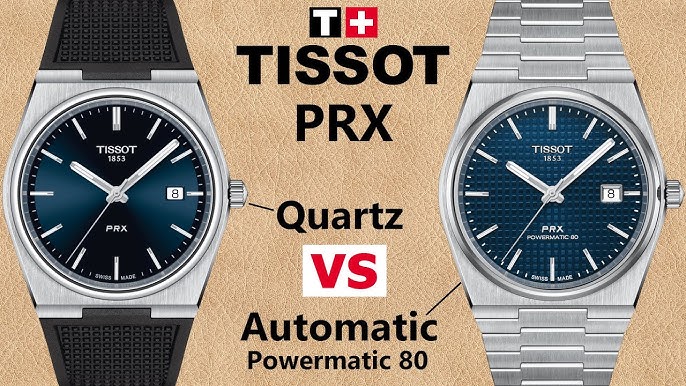The Tissot PRX collection has become a favorite among watch enthusiasts for its sleek 1970s-inspired design and impressive build quality. Available in both quartz and automatic (Powermatic 80) versions, the PRX offers something for every wrist and budget. But which one should you buy? The answer depends on what you value more—affordability and convenience, or mechanical heritage and craftsmanship. Let’s break down the pros and cons of both models to help you make the right choice.
Tissot PRX Quartz: Practical and Affordable
✅ Pros:
-
Affordable Entry Point: The quartz PRX typically costs significantly less than the automatic version, making it ideal for budget-conscious buyers or first-time watch enthusiasts.
-
Slim Profile: Thanks to the thinner quartz movement, the case is sleeker (around 10.4mm), making it exceptionally comfortable for daily wear and suitable for smaller wrists.
-
Low Maintenance: Quartz movements require minimal upkeep—just a battery change every few years. They’re reliable and fuss-free.
-
Superior Accuracy: Quartz movements are far more accurate than mechanical ones, losing just a few seconds per month.
❌ Cons:
-
Lacks Mechanical Appeal: Enthusiasts who admire traditional watchmaking might find quartz less exciting due to the absence of a sweeping second hand or visible movement.
-
No Display Caseback: Unlike the automatic, the quartz version doesn’t offer a transparent caseback to showcase the movement.
Tissot PRX Automatic (Powermatic 80): Mechanical Elegance
✅ Pros:
-
Mechanical Movement: The Powermatic 80 features an 80-hour power reserve, anti-magnetic Nivachron balance spring, and a smooth sweeping second hand—hallmarks of Swiss watch craftsmanship.
-
Sapphire Caseback: A transparent exhibition caseback allows you to admire the movement, adding a sense of artistry and sophistication.
-
Collector’s Appeal: Automatic watches are often seen as more valuable and desirable to collectors due to their engineering and legacy.
-
Emotional Value: Many wearers find mechanical watches more meaningful due to the human touch involved in their design and operation.
❌ Cons:
-
Higher Price: The automatic PRX is significantly more expensive than its quartz sibling, though still competitively priced among Swiss automatics.
-
Thicker Case: At around 11mm thick, the automatic model is bulkier than the quartz, which might be less ideal under tight cuffs.
-
Requires Regular Wear or Winding: To keep accurate time, you must either wear it frequently or wind it manually if it stops.
Final Verdict: Which One Should You Buy?
-
Choose the PRX Quartz if you want a low-maintenance, stylish, and affordable Swiss watch with excellent accuracy and comfort.
-
Go for the PRX Automatic if you appreciate mechanical movements, craftsmanship, and the emotional connection of wearing a finely engineered timepiece.
Both models deliver outstanding design and build quality, but your choice depends on whether you prefer practicality or mechanical passion.
